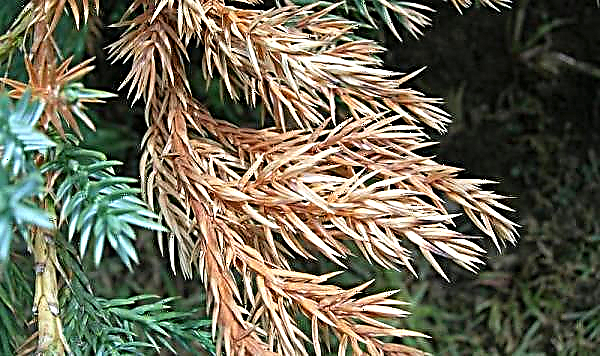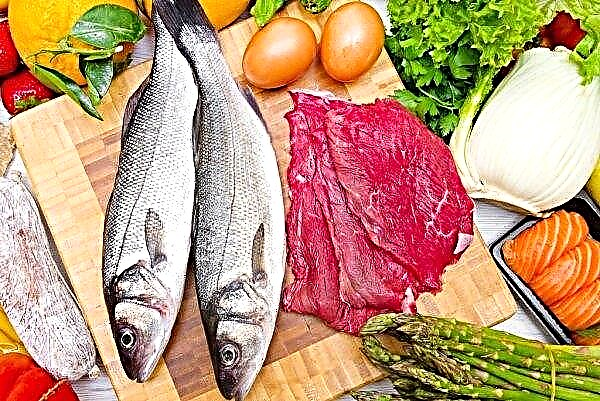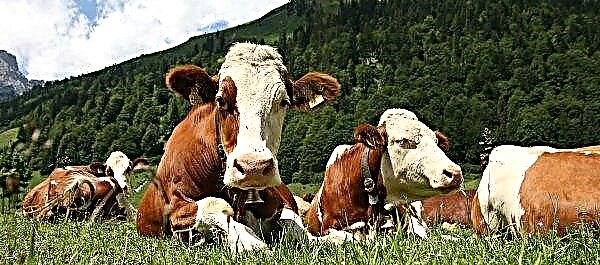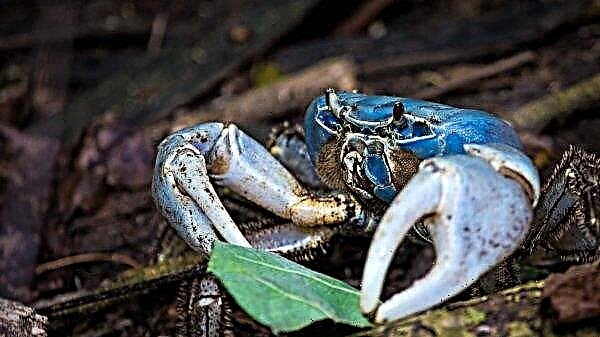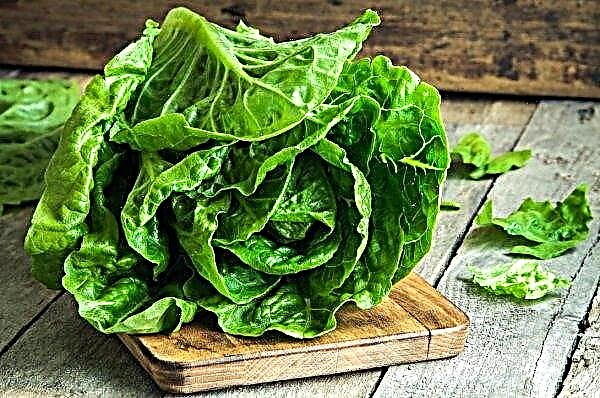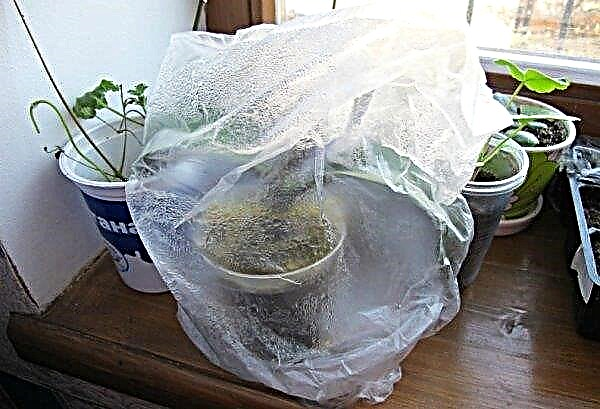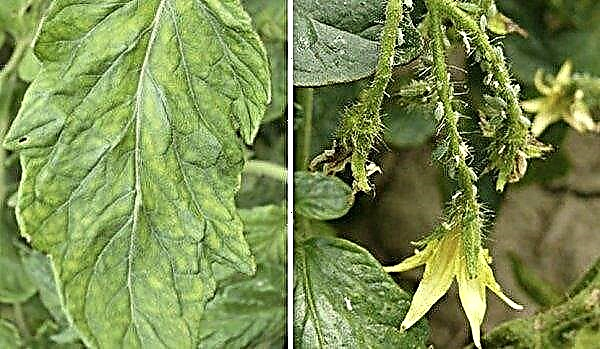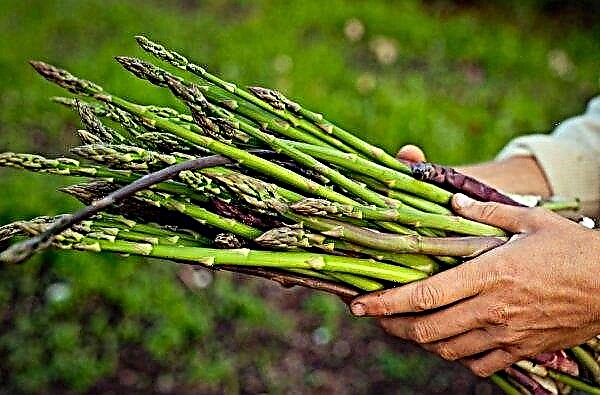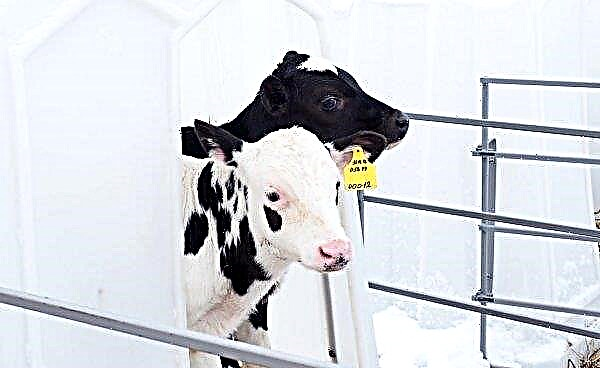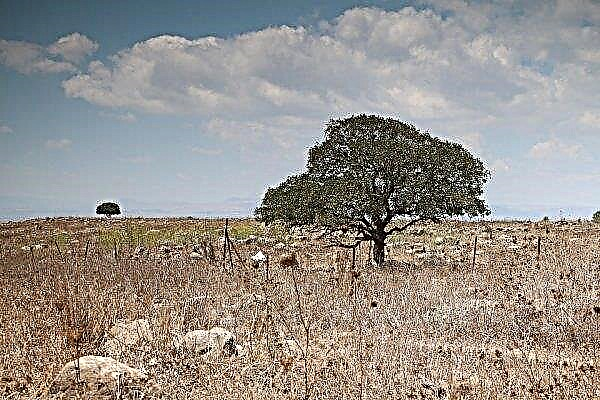The famous Astrakhan watermelon variety was created by breeders under the leadership of K. E. Dupin. The purpose of selection in this case is to develop a variety with a perfectly round fruit shape and high taste, which Astrakhan corresponds to. Our article will tell you what the fruit of the variety in question looks like, how to grow watermelon in a greenhouse and in an open area, the rules of agricultural technology, and how to determine the timing of harvesting.
Description and characteristics of the variety
Watermelon Astrakhan was included in the State Register of selection plants in 1977 and still has not lost popularity. The variety is recommended for cultivation in the Urals, the North Caucasus, in the Volga region.
The following distinctive characteristics will help solve the question of how to distinguish Astrakhan from other varieties:
- mid-ripening, with a maturity of 70–80 days;
- the fruit is round, thick-skinned, with alternating blurry stripes of dark green and light color;
- fetal weight - 6–8 kg;
- matures in late August;
- storage up to two months, without loss of taste;
- productivity - 50 t / ha;
- highly branched root system with a central meter root, lateral roots are located at a depth of 20-30 cm;
- stalk liana-like creeping, up to 4–5 m long, branched with lateral shoots;
- leaves are split, gray-green, young leaves are pubescent;
- the flesh is fine-grained, bright red, sweet in taste, juicy with vacuoles of juice;
- dry seeds of dark brown color;
- unpretentious in care, can be grown in a greenhouse and in an open area;
- resistant to gourds.
On the cultivation of the Astrakhan variety, farmers set yield records, and sellers set revenue records.Important! The stronger the contrast of the stripes on the peel, the sweeter and juicier the flesh.
Advantages and disadvantages
- Grade advantages:
- ripe watermelon is sweet and juicy;
- attractive appearance with bright coloring;
- cultivation in an indoor greenhouse and in an open area;
- resistance to drought and diseases of gourds;
- high-yielding variety;
- transportable;
- unpretentiousness in cultivation;
- long shelf life;
- inexpensive seed and availability on the market;
- high profitability.
- The disadvantages of the variety include:
- the need for additional care when growing;
- exactingness to dry and hot climate;
- increase in costs due to fertilizing and fertilizing.
Optimal timing for growing
Cultivation of watermelon is carried out by seedling and seedling method. To determine the optimal timing of sowing for seedlings, it is necessary to calculate it according to the following formula:
- last frost for growing region - for example, mid-May;
- seedling age - 30 days;
- pre-soaking - 7 days.
From the calculation it turns out that the sowing should be carried out in early April. This formula is used when cultivating in a greenhouse, and in an open area. If seedlings are planted under cover, then sowing can be carried out 7 days earlier.
Seeds in open ground are also sown, depending on weather conditions - it is necessary that the earth warms up and there is no threat of frost. Usually sowing begins in May.
Preparatory work
Preparatory work for growing watermelons consists in preparing a plot for melon and seeds for sowing.
Site selection and preparation
When choosing a site for crops, it is necessary to consider the following factors:
- Climatic conditions - hot and dry air, low humidity.
- Shine. After the appearance of 5-6 sheets, high illumination and daylight hours of 12 hours are required. Fruits do not set during a long daylight; plant growth slows when illuminated for less than 8 hours.
- The soil - the culture does not like clay soils with an excess of moisture and high acidity. The best soil is light sandy and desert, well-cultivated virgin soil. The soil acidity is 6.6–7 pH. It is necessary to prepare the soil in the fall by introducing humus and mineral fertilizers that contain potassium, phosphorus, nitrogen and magnesium.
- Crop rotation. Repeated crops of watermelons on the site are carried out in 3-4 years. The best areas are those where wheat, herbs, corn, alfalfa, root crops, onions, cabbage, and legumes grew. Planting sites after solanaceous and melon should be avoided.
Important! Watermelons grow small on chernozem soil due to the large amount of nitrogen, which contributes to the growth of green mass to the detriment of fruit development.
The site should be protected from northern and western cold winds and drafts by planting tall crops or hedges, prepare beds for watermelons on the south or southeast side.
Seed preparation
With the seedling and seedling method of sowing, it is advisable to pre-germinate the seeds. Purchased seeds are usually processed and prepared for planting.
Otherwise, seed preparation should be carried out independently:
- soak the seeds in a solution of "Epin Extra" or in a pink solution of potassium permanganate for 12 hours to soften the shell and disinfect;
- after the time has passed, place the seeds in a damp cloth, cover with a film and place in a warm place (+ 28 ° C) for 4–5 days, preventing the fabric from drying out;
- not sprouted seeds can be shed with water + 50 ° С ... + 60 ° С.
When the first sprouts appear, you can start planting either in seedlings, or directly in the soil.

Cultivation methods
In the southern latitudes with dry and sultry summers, watermelons are sown with seeds on an open area, in other regions it is advisable to use greenhouses for the successful ripening of fruits. For an early harvest, it is advisable to use the seedling method.
Seedling method
Seedlings can be grown for subsequent planting in an open area and in a greenhouse.
- The advantages of the seedling method:
- receiving fruits 1-2 weeks earlier;
- effective use of seeds;
- reduced risk of germination of seedlings;
- uniform depth of planting in the soil.
- Minuses:
- economic costs;
- damage to plants during transplantation;
- weaker root system.
- substrate without weeds and pests;
- suitable temperature, light and humidity modes;
- top dressing;
- hardening and watering.
Did you know? In arid regions, you can “plant” a watermelon on a camel spine: cut a bush, split a stump and insert a seed - moisture will be provided.
Landing time
When choosing the timing of sowing seeds, the vegetation period of the Astrakhan watermelon should be taken into account. For indoor use and seedlings, seeds can be sown from late March to mid-April.
Landing technology
The root system of the watermelon is very sensitive to transplanting, therefore it is advisable to sow the seeds in containers, which can later be used for transplanting seedlings into the soil, for example, into peat cups.
Seeds are sown one at a time to a moist substrate to a depth of 1.5–2 cm, compacting and watering with a small amount of water. Subsequently, the seedlings are watered when the substrate dries.
At a temperature of + 25 ° С ... + 30 ° С the seeds will germinate on the fifth day.
Seedling Care
Seedling care is the key to a future successful harvest, and it should be ensured by the following measures:
- Watering. Seedlings need a rare but plentiful watering with warm and settled water when the soil dries by 1–1.5 cm. Before planting in the ground, the irrigation frequency is reduced.
- Lighting and temperature. When the first shoots appear, seedlings are placed in a sunny place with a temperature of + 18 ... + 20 ° С. After a week they can be rearranged to a warmer place with a temperature of + 24 ... + 25 ° С. Seedlings tend to stretch toward the light, so the tank is periodically rotated. With a lack of lighting, it must be illuminated with phytolamps. The optimal temperature regime of the greenhouse should be + 25 ... + 26 ° С.
- Hardening. Two weeks before planting on the soil, seedlings begin to be hardened, taking them out to fresh air, gradually increasing walk time and reducing the frequency of watering. Hardened seedlings acquire resistance to cold, drought, and actively grow roots.
- Fertilizer application. The first top dressing is carried out a week after the first seedlings, the second - a week before planting in the soil. The need for fertilizer can be determined by the appearance of the seedlings - slow growth, dropping leaves, elongated and weak stalk. You can use ready-made fertilizers for seedlings according to the instructions ("Agricola", "Forward").
Important! When hardening, you should carefully monitor the condition of the soil, since under the influence of atmospheric factors, the soil under seedlings dries faster.
Before planting in a permanent place, seedlings are preferably treated with biostimulants (Zircon, Radifarm) to overcome plant stress during transplantation and better rooting. The procedure should be repeated after a week.
Planting seedlings in the ground
In the greenhouse and in the beds, the place for seedlings should be prepared in advance: they dig the soil, form holes 80 × 80 × 20 cm, which are filled with humus, ash, sand and sprinkled with a 2 cm layer of earth.
Seedlings are planted in the soil at the age of 3-5 weeks, provided stable warm weather, slightly deepening. Planting depth - 6-10 cm, the distance between the shoots - 80-100 cm.
Immediately carry out watering to compact the soil and better rooting. The beds with seedlings are mulched or covered with a film. The next watering is carried out in two weeks.
Seed directly into the ground
Direct sowing of seeds in the soil is the most economical method of cultivating watermelons.
The soil under crops should be air- and moisture-permeable, beds are equipped with good drainage. Sowing is carried out in steadily warm weather with a daily temperature of + 14 ... + 20 ° C and well-warmed soil (+ 12 ° C), when the threat of frost passes. Usually this is mid to late May.
Wells under the seeds are fertilized with humus, sprinkled with earth (about 10 cm).
Video: Planting watermelon seeds in open ground
Row spacing should be 1-1.5 m wide, the distance between holes - 80-100 cm. Sowing is similar to the greenhouse version, but when seedlings appear, they are sent in different directions. In the greenhouse, seedlings are tied up, forming vertical lashes.
Seeds are put in 2-3 pieces per hole, slightly crushing. The depth of sowing seeds is 3–6 cm, depending on the type of soil (on the light - deeper, on heavy - smaller). The soil in the wells should be well moistened. Sowing is preferably carried out before noon.
Sowing depth depends on land reclamation:
- on irrigation - 4–5 cm:
- on a dry land (without watering) - 6–8 cm.
Seeds germinate on day 8-10. On light sandy soils, seedlings germinate 10 days earlier than on chernozem. Seeds germinate slowly and unevenly from cold soil, which leads to difficulty in care and a heterogeneous crop.
Care Features
The main rules for growing melon are to moisturize, fertilize and provide care. Further care is reduced to thinning seedlings, watering, loosening, weeding and top dressing.
Photophilous culture does not tolerate shading and thickening of plantings. One sprout should remain in one hole - no more than three plants per 1 m².
Mulching planting with mulch (4-5 cm) or films provides:
- decreased weed growth;
- heat preservation in the soil;
- moisture retention in the soil;
- Harvesting 7-10 days faster.
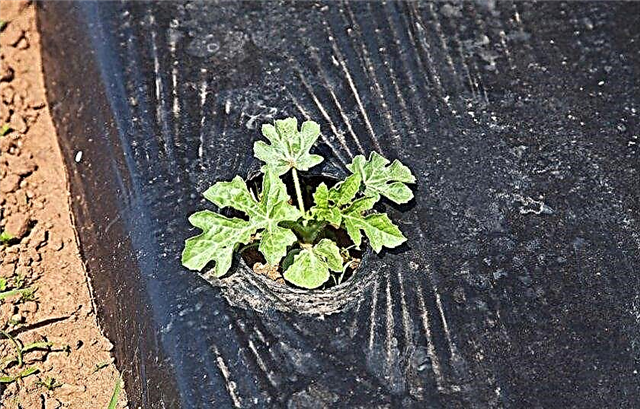
Effective pollination occurs with the help of bees and insects and also increases the yield and quality of watermelons. It is recommended to place additional beehives near the melon plantings during flowering and not to use sprinkling.
A feature of growing in a greenhouse is that each flower in the absence of insects will have to be pollinated independently. Artificial pollination is carried out in the morning, at a temperature not exceeding + 18 ... + 20 ° C.
Timely weeding will not allow weeds to take useful substances from watermelon stems, eliminate shading, and reduce the risk of developing diseases. Together with weeds, damaged and weak shoots are removed.
Watering rates
The root system of watermelon has a high suction capacity even with low (6%) soil moisture - this explains the drought tolerance of the culture. However, to obtain high and high-quality yields, watering watermelon is necessary. To obtain the declared yield of the Astrakhan (50 t / ha) watermelon, 160 liters of water will be required.
The plant needs the most moisture in the flowering and ovary formation phase. But excess moisture (in soil, air) slows down growth and reduces sugar content. The optimum ratio of soil moisture is up to 80%, air - up to 60%.
There are three types of watermelon irrigation:
- groove irrigation along crops;
- drip irrigation allows the economical use of water, water-soluble fertilizers;
- sprinkling makes it possible to evenly distribute water across the field.
- growth and flowering phase - watering at least once every 5-7 days;
- ovary formation and fruit development - the frequency and volume of irrigation is reduced;
- fruit ripening phase - 10 days before harvesting, irrigation is stopped to accelerate ripening and set sugar content;
- irrigation is carried out with warm water.
Important! During ripening, plentiful watering and top dressing lead to decay of the fetus. Frequent and plentiful watering reduces sugar content.
Top dressing
The rational and balanced use of fertilizers can double productivity, and sugar content of fruits - by 2-3%.
Feeding at different periods of growth and development of watermelon:
- Beginning of flowering. The first top dressing is carried out in the watering grooves when the lashes grow to 40 cm - the growth stimulator "Speedfall Amino Flowering and Fruiting", a manure solution in a ratio of 1:10, nitrogen and potassium phosphorus fertilizers.
- Ovary formation. The second top dressing is Terraflex, Green, Plantafol, Megafol, Terraflex Universal.
- Fruit formation (one month before ripening). The third top dressing is calcium nitrate (calcium nitrate).

It is advisable to alternate nutrients to avoid the accumulation of elements in the soil. All drugs should be used according to the instructions and consumption standards.
Important! Do not fertilize more often than once a week: excessive accumulation of chemicals in the fruit is possible. Do not fertilize in hot weather.
The formation of the bush and pinch
The formation of lashes of watermelon depends on the region of cultivation, because this procedure is aimed at creating conditions for the ripening of the ovaries:
- in the northern regions, it is desirable to leave 1-3 ovaries and pinch the lash;
- in the southern regions, you can leave 5-6 fruits due to the long and sultry summer.
 In order to avoid thickening of plantings, the plant is formed into one stem, removing stepsons.
In order to avoid thickening of plantings, the plant is formed into one stem, removing stepsons.A feature of the Astrakhan cultivar is that female flowers appear only after every eighth leaf, and the first after the eighteenth. This must be considered when forming a whip.
Pests and diseases
The main methods of combating watermelon diseases are compliance with crop rotation rules, seed treatment before sowing, and the use of resistant varieties, such as Astrakhan.
Careful monitoring of gourds will allow you to notice the defeat of pests and diseases in time:Did you know? Watermelon is 93% water, so it is considered the lowest calorie among gourds.100 g of pulp contains only 27 kcal.
- Disease prevention is treated with Bordeaux fluid in the phase of ejection of lashes and the formation of ovaries, the Epin phytohormones (during rain and cold) or Zircon (during drought).
- Antibacterial spraying ("Fitosporin M", "Baikal", "Haupsin", "Trichophytum", "Trichopolum", "Metronidazole") are used after the appearance of 7-9 leaves before the appearance of the fruits in order to avoid damage to the root system of plants by pests.
- Fetal growth arrest, black, red or red spots on stems and leaves, leaves are broken and fall off - signs anthracnose (Recommended treatment with fungicides in accordance with the instructions).
- Against downy mildew - fungicide with the systemic properties of Previkur and Previkur Energy.
- At bacteriosis, fusarium wilt - treatment with fungicides (“Skor”, “Fundazol”, “Decis”) according to the instructions.
- Defeat aphids, thrips - special modern insecticides ("Arrivo", "Decis", "Karate", "Fastak", "Fury", "Tsimbush", "Citkor", "Sherpa") or folk remedies (spraying with infusion of garlic or ash).
- Against defeat spider mite - effective means of a group of acaricides ("Masai", "Apollo", "Oberon").
- Bird protection a cassette tape stretched over pegs can serve, which with its rustle will scare them away.
- Slowing plant growth, lower leaves curl and fall, acquiring a reddish or lilac color, fruits and flowers are fading - signs magnesium deficiency. In this case, magnesium sulfate should be used, after 5 days, spray with “Ferovit” to consolidate the result.

Harvesting and storage rules
The harvesting time of the watermelon Astrakhan is determined by the characteristics of the vegetation, which lasts 80 days.
Natural conditions cannot provide such accuracy, therefore it is necessary to determine the ripeness and time of harvesting watermelons according to the signs:
- drying of the stalks and antennae;
- cracking watermelon during compression;
- a dull echo when tapped.
Fruits are carefully collected, avoiding damage to the skin, as they ripen, tearing off, and even better cutting off with lashes along with the stem. The period of mass gathering is the end of August - the beginning of September. The collection is best organized a week before the final ripeness, which will ensure maximum taste and shelf life.
Freshly picked watermelon should be consumed within 2-3 weeks.
Storage rooms for watermelons should provide:Important! You can not store watermelons in direct sunlight: when heated, nitrates are converted to nitrites, more dangerous compounds for health.
- temperature + 4 ... + 8 ° С;
- humidity is about 80%;
- good ventilation and dry floor;
- lack of direct sunlight;
- lack of other vegetable and fruit crops (potatoes, beets, apples).
There are other storage methods that can extend the time by several months and serve the collected watermelons to the New Year's table:
- hang fruits in nets one at a time, avoiding touching the floor and walls;
- put the stalks up on shelves covered with straw;
- put storage containers with dried forest moss;
- store in containers, completely covered with ash;
- storage in paraffin (1 cm layer).
The fruit itself does not tolerate temperatures below zero, but the flesh, cleared of seeds and crusts, can be frozen and stored in the freezer.
Useful Tips
When growing and eating watermelons, you can use the tips and tricks of knowledgeable gardeners and specialists:
- for better pollination, next to watermelons, you can plant melliferous plants or spray plantings with water, honey and sugar;
- additional heat on the melon can be provided by water bottles laid out next to the ovaries - when heated in the sun, they will give part of the heat to the fruits;
- to get rid of nitrates, it is enough to cut off the crust and part (2-3 cm) of the pulp;
- on melon, watermelons should be turned over as they mature, so that moisture does not accumulate under them and rot does not begin;
- cross-pollination can damage the crop, so do not plant different varieties of pumpkin crops nearby;
- four medium pieces will provide the body with the daily norm of vitamin C;
- in addition to fresh consumption, salted watermelons, candied fruits, and nardek - watermelon honey can be prepared for future use;
- watermelon seeds should not be sent to waste - they have many useful properties;
- when drinking watermelon, it is useful to drink a lot of mineral water, since mineral substances are washed out from the body due to the diuretic effect;
- sugar grains are visible in the section of a high-quality watermelon, a glossy section indicates poor quality;
- the degree of ripeness of the watermelon can be determined by such signs - a dry stalk, a characteristic crack when squeezed, a large yellow spot from contact with the ground, a bright color.
Did you know? Candied mango, kiwi and pineapple made in China have nothing to do with these fruits, but are made from not very sweet fodder watermelon.
Having considered all the features of the watermelon of the Astrakhan variety and taking into account the climatic conditions of your region, you can choose the right method of growing these plants - on the site or in the greenhouse, and the reward for your efforts will be a plentiful harvest.




